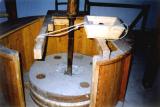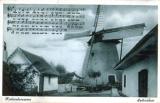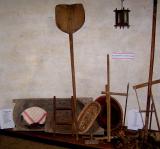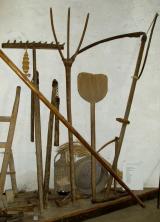2024. April 23. Tuesday
Dorozsma Windmill - Szeged - Kiskundorozsma
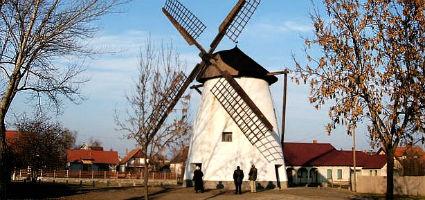 |
Address: 6791, Szeged - Kiskundorozsma Szélmalom u. 2/A
Phone number: (62) 463-112, (20) 954-2124
E-mail: szelmolnar51@freemail.hu
Opening hours: 01.03-30.10.: Tue-Sun 14-18
|
Before World War II there were only ten wind mills in operation in Kiskundorozsma. After the war this number decreased to one. This mill was built by Andor Czékus in 1821. Later, György Faragó purchased it in 1900. At the beginning it was used for grinding grains in several qualities. The work was done as a family business. To use out the seasonal winds, the mill many times was running day and night. Sometimes, because of lack of adequate winds, the business had to stop for days or even weeks.
After the death of György Faragó in 1949, the condition of the mill gradually got worse, for the family did not use it. In 1961 it was declared a monument, yet the state of the wind mill was getting worse and worse. According to Antal Joó, worker of the local council of the time, Antal Práger actor and the leader of the Registery Office were the last two visitors of the mill.
The spring of 1970 was a time for woking against the destructions of the floods. Many buildings became uninhabitable. Because of the waters the walls of the mill could not hold the roof any more, and on 22nd April 1970 it collapsed. Only a 2,5 by 2 meters section of the wall remained standing.
According to Hunarian principles, monument reconstructions are normally not reccomended. Yet here was a different case. The citizens adhered to the last wind mill of the settlement. The local authorities and other government offices too thought it necessary that the mill should be rebuilt, and that by using modern bricks, iron etc. materials. The National Monument Protecting Authority finally decided to build the mill according to the original materials and structures.
The whole of the wooden structure of the mill was found. According to the sketches of Béla Faragó (son of György Faragó) the various pieces were marked and then shipped to the building of the local council. However, because of inappropriate storing, the parts became moldy and unusable for rebuilding.
Exact measurements of the building were calculated by Antal Horn, researcher of the Technical University of Budapest. Then the remainder of the wall was pulled down. Only three lines of bricks remained still usable. Static measuring suggested that the foundation shold be made of a 1-metre deep ferroconcrete layer, on the top of which could come the mill built by traditional materials and methods.
Reconstruction works started in the autumn of 1972. Vince Nagy Torma wind miller, Istvánt Horváth and Andrást Ladányi were hired as builders. The source material of the walls were prepared by several local mud brick makers, who were doing the work by using traditional methods and materials, that is, a certain type of alkaline soil mixed with chaff.
To separate the floors the builders used new wooden materials, but some part of the moldy structure was supplemented by another one taken from a similar mill in Balástya. Several parts had to be remade, and the craftsmen making these parts marked their names into the most important parts.
The roof also had to be remade. This was also done in the traditional thatched way. Walls were covered by chaffed mud inside and out, and were limed three times afterwards. The main structural pieces were made by new materials, apart from the iron works. The same can be said regarding the locksmith works.
Béla Sisa, worker of the National Monument Protection Authority, wrote the following about the building: "Reconstruction of the wind mill was finished in spring 1973. The mill started working again. Sweet corns and wheet were ground as the first test of its operation."
József Vass
After the death of György Faragó in 1949, the condition of the mill gradually got worse, for the family did not use it. In 1961 it was declared a monument, yet the state of the wind mill was getting worse and worse. According to Antal Joó, worker of the local council of the time, Antal Práger actor and the leader of the Registery Office were the last two visitors of the mill.
The spring of 1970 was a time for woking against the destructions of the floods. Many buildings became uninhabitable. Because of the waters the walls of the mill could not hold the roof any more, and on 22nd April 1970 it collapsed. Only a 2,5 by 2 meters section of the wall remained standing.
According to Hunarian principles, monument reconstructions are normally not reccomended. Yet here was a different case. The citizens adhered to the last wind mill of the settlement. The local authorities and other government offices too thought it necessary that the mill should be rebuilt, and that by using modern bricks, iron etc. materials. The National Monument Protecting Authority finally decided to build the mill according to the original materials and structures.
The whole of the wooden structure of the mill was found. According to the sketches of Béla Faragó (son of György Faragó) the various pieces were marked and then shipped to the building of the local council. However, because of inappropriate storing, the parts became moldy and unusable for rebuilding.
Exact measurements of the building were calculated by Antal Horn, researcher of the Technical University of Budapest. Then the remainder of the wall was pulled down. Only three lines of bricks remained still usable. Static measuring suggested that the foundation shold be made of a 1-metre deep ferroconcrete layer, on the top of which could come the mill built by traditional materials and methods.
Reconstruction works started in the autumn of 1972. Vince Nagy Torma wind miller, Istvánt Horváth and Andrást Ladányi were hired as builders. The source material of the walls were prepared by several local mud brick makers, who were doing the work by using traditional methods and materials, that is, a certain type of alkaline soil mixed with chaff.
To separate the floors the builders used new wooden materials, but some part of the moldy structure was supplemented by another one taken from a similar mill in Balástya. Several parts had to be remade, and the craftsmen making these parts marked their names into the most important parts.
The roof also had to be remade. This was also done in the traditional thatched way. Walls were covered by chaffed mud inside and out, and were limed three times afterwards. The main structural pieces were made by new materials, apart from the iron works. The same can be said regarding the locksmith works.
Béla Sisa, worker of the National Monument Protection Authority, wrote the following about the building: "Reconstruction of the wind mill was finished in spring 1973. The mill started working again. Sweet corns and wheet were ground as the first test of its operation."
József Vass
